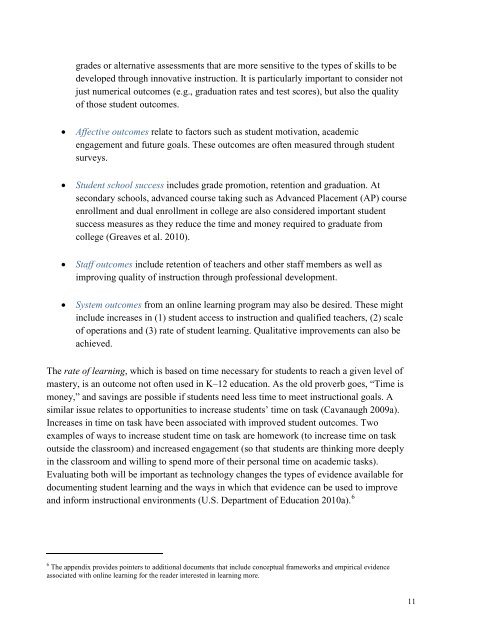Download PDF - SRI International
Download PDF - SRI International
Download PDF - SRI International
You also want an ePaper? Increase the reach of your titles
YUMPU automatically turns print PDFs into web optimized ePapers that Google loves.
grades or alternative assessments that are more sensitive to the types of skills to be<br />
developed through innovative instruction. It is particularly important to consider not<br />
just numerical outcomes (e.g., graduation rates and test scores), but also the quality<br />
of those student outcomes.<br />
• Affective outcomes relate to factors such as student motivation, academic<br />
engagement and future goals. These outcomes are often measured through student<br />
surveys.<br />
• Student school success includes grade promotion, retention and graduation. At<br />
secondary schools, advanced course taking such as Advanced Placement (AP) course<br />
enrollment and dual enrollment in college are also considered important student<br />
success measures as they reduce the time and money required to graduate from<br />
college (Greaves et al. 2010).<br />
• Staff outcomes include retention of teachers and other staff members as well as<br />
improving quality of instruction through professional development.<br />
• System outcomes from an online learning program may also be desired. These might<br />
include increases in (1) student access to instruction and qualified teachers, (2) scale<br />
of operations and (3) rate of student learning. Qualitative improvements can also be<br />
achieved.<br />
The rate of learning, which is based on time necessary for students to reach a given level of<br />
mastery, is an outcome not often used in K–12 education. As the old proverb goes, “Time is<br />
money,” and savings are possible if students need less time to meet instructional goals. A<br />
similar issue relates to opportunities to increase students’ time on task (Cavanaugh 2009a).<br />
Increases in time on task have been associated with improved student outcomes. Two<br />
examples of ways to increase student time on task are homework (to increase time on task<br />
outside the classroom) and increased engagement (so that students are thinking more deeply<br />
in the classroom and willing to spend more of their personal time on academic tasks).<br />
Evaluating both will be important as technology changes the types of evidence available for<br />
documenting student learning and the ways in which that evidence can be used to improve<br />
and inform instructional environments (U.S. Department of Education 2010a). 6<br />
6 The appendix provides pointers to additional documents that include conceptual frameworks and empirical evidence<br />
associated with online learning for the reader interested in learning more.<br />
11
















